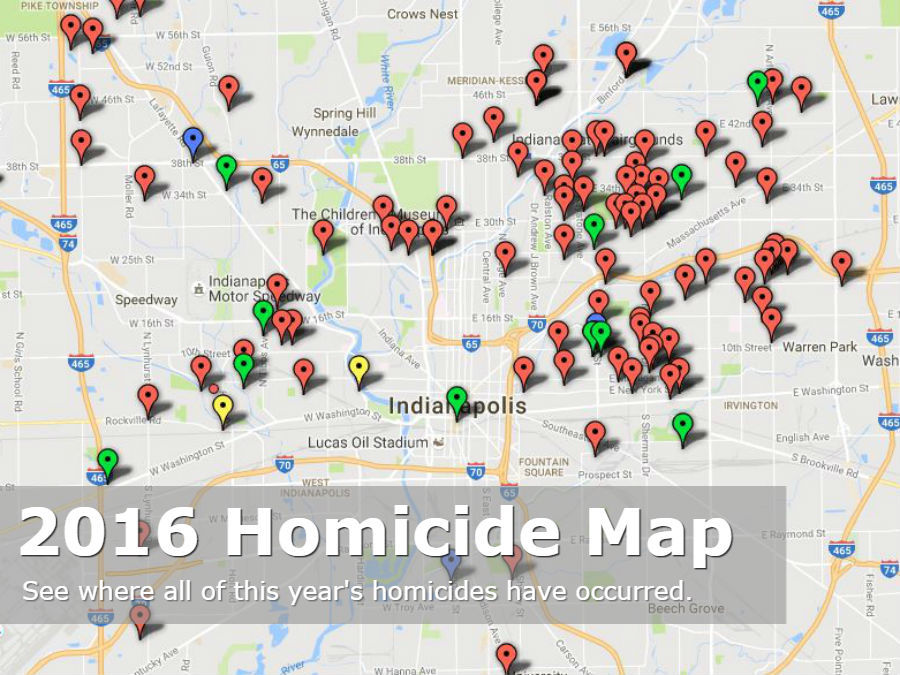INDIANAPOLIS -- For the second year in a row, Indianapolis has broken its record for criminal homicides.
Maybe.
Officially, IMPD says there were 144 homicides in Indianapolis in 2015. As of the writing of this article, there have been at least 145 criminal homicides in Indianapolis in 2016, and police are investigating a badly burned body as a suspicious death – potentially making the total 146.
INDIANAPOLIS VIOLENCE MAPPED OUT | 2015 Indianapolis Homicides | 2016 Indianapolis Homicides | 2016's Deadliest Neighborhoods | 2016 Unsolved Homicides
Normally, that would be where the story ends. But characterizing a year as the "deadliest ever" comes with it some particular challenges.
For one thing, the Uniform Crime Report IMPD submitted to the FBI for 2015 listed 148 criminal homicides for the year – four more than their official total.
Sgt. Kendale Adams says the department is working to "reconcile" those numbers.
"Those numbers should be the same," he said. "There shouldn't be two different numbers."
But IMPD's own internal dispute underscores the difficulty in nailing down the answer to just how many people were murdered in Indianapolis in 2015.
Take, as just two examples, the deaths of Michael Killebrew and Derrick Gregory, both 30.
Gregory was shot and killed on Nov. 25, 2015, while driving on I-70 on the east side of Indianapolis. But because the shooting happened on I-70, it was investigated by the Indiana State Police and not by IMPD, and therefore not counted in IMPD's numbers.
Killebrew was shot a few days later, on Dec. 1, 2015, on the 1000 block of West 29th Street. He didn't die of his injuries until Jan. 16, 2016. IMPD counts him as a 2016 homicide.
"If somebody gets shot Dec. 31 of this year, and they die January 2, they count it in the current year," Adams said. "They don't go back and change that 144 to 145."
Adams said IMPD wasn't sure who the additional four homicide victims reported in its UCR were. That number could include Killebrew and Gregory, or, Adams said, potentially represent shootings that were ruled self-defense by the prosecutor's office but which meet the FBI's definition of a criminal homicide.
"Even though we're the same department, we sometimes work with different definitions of things," Adams said.
While we're talking about question marks in the homicide record, it should also be made clear that 2016 has some as well. The death of 44-year-old James Rice illustrates that perfectly.
Rice's dismembered body was discovered in the White River near White River Parkway West Drive and New York Street on April 17. More than eight months later, an official ruling has never been announced as to whether Rice's case is a criminal homicide.
(We should also note that a call to the homicide detective in charge of the case asking for clarification on its status was not returned.)
If there is a bottom line, it's this: Officially, 2016 is now the deadliest year on record in Indianapolis history. It's also the second year in a row to earn that distinction, and the sixth year in a row that homicides have increased in Indianapolis. Overall, the city's yearly homicide rate has increased by 57 percent since 2010.
If IMPD's effort to "reconcile" its numbers results in 2015's total being increased – and 2016 therefore becoming "just one" of the deadliest years on record, rather than "the deadliest" – the fact remains that the systemic issues which have caused increasing violence in Indianapolis remain intact, and that, if the trend is not addressed, Indianapolis could, for the third year in a row, see its deadliest year ever again in 2017.



